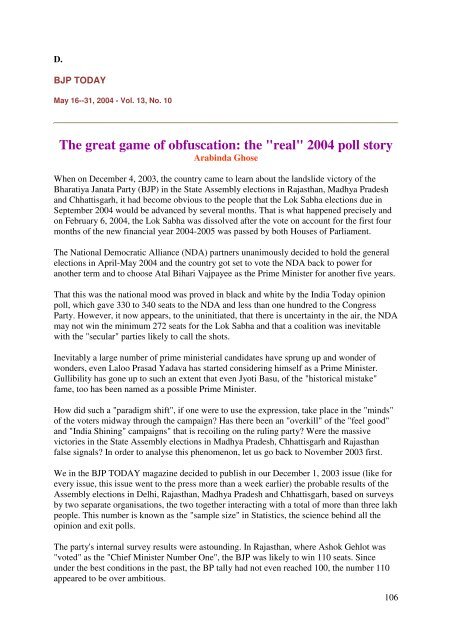Hindutva, Hindunasjonalisme og Bharatiya Janata Party En ...
Hindutva, Hindunasjonalisme og Bharatiya Janata Party En ...
Hindutva, Hindunasjonalisme og Bharatiya Janata Party En ...
You also want an ePaper? Increase the reach of your titles
YUMPU automatically turns print PDFs into web optimized ePapers that Google loves.
D.<br />
BJP TODAY<br />
May 16--31, 2004 - Vol. 13, No. 10<br />
The great game of obfuscation: the "real" 2004 poll story<br />
Arabinda Ghose<br />
When on December 4, 2003, the country came to learn about the landslide victory of the<br />
<strong>Bharatiya</strong> <strong>Janata</strong> <strong>Party</strong> (BJP) in the State Assembly elections in Rajasthan, Madhya Pradesh<br />
and Chhattisgarh, it had become obvious to the people that the Lok Sabha elections due in<br />
September 2004 would be advanced by several months. That is what happened precisely and<br />
on February 6, 2004, the Lok Sabha was dissolved after the vote on account for the first four<br />
months of the new financial year 2004-2005 was passed by both Houses of Parliament.<br />
The National Democratic Alliance (NDA) partners unanimously decided to hold the general<br />
elections in April-May 2004 and the country got set to vote the NDA back to power for<br />
another term and to choose Atal Bihari Vajpayee as the Prime Minister for another five years.<br />
That this was the national mood was proved in black and white by the India Today opinion<br />
poll, which gave 330 to 340 seats to the NDA and less than one hundred to the Congress<br />
<strong>Party</strong>. However, it now appears, to the uninitiated, that there is uncertainty in the air, the NDA<br />
may not win the minimum 272 seats for the Lok Sabha and that a coalition was inevitable<br />
with the "secular" parties likely to call the shots.<br />
Inevitably a large number of prime ministerial candidates have sprung up and wonder of<br />
wonders, even Laloo Prasad Yadava has started considering himself as a Prime Minister.<br />
Gullibility has gone up to such an extent that even Jyoti Basu, of the "historical mistake"<br />
fame, too has been named as a possible Prime Minister.<br />
How did such a "paradigm shift", if one were to use the expression, take place in the "minds"<br />
of the voters midway through the campaign? Has there been an "overkill" of the "feel good"<br />
and "India Shining" campaigns" that is recoiling on the ruling party? Were the massive<br />
victories in the State Assembly elections in Madhya Pradesh, Chhattisgarh and Rajasthan<br />
false signals? In order to analyse this phenomenon, let us go back to November 2003 first.<br />
We in the BJP TODAY magazine decided to publish in our December 1, 2003 issue (like for<br />
every issue, this issue went to the press more than a week earlier) the probable results of the<br />
Assembly elections in Delhi, Rajasthan, Madhya Pradesh and Chhattisgarh, based on surveys<br />
by two separate organisations, the two t<strong>og</strong>ether interacting with a total of more than three lakh<br />
people. This number is known as the "sample size" in Statistics, the science behind all the<br />
opinion and exit polls.<br />
The party's internal survey results were astounding. In Rajasthan, where Ashok Gehlot was<br />
"voted" as the "Chief Minister Number One", the BJP was likely to win 110 seats. Since<br />
under the best conditions in the past, the BP tally had not even reached 100, the number 110<br />
appeared to be over ambitious.<br />
106
















